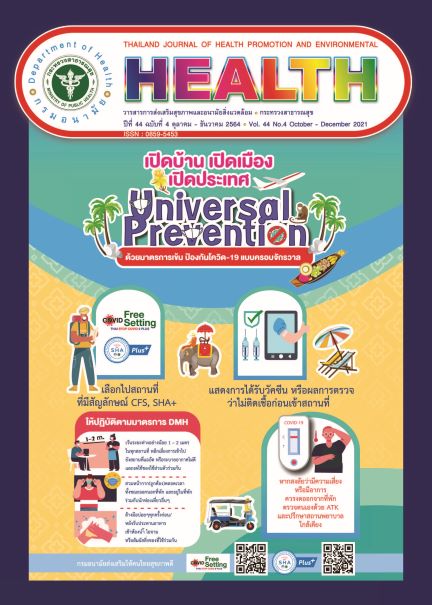การพัฒนาหลักสูตรอบรมอาสาสมัครแรงงานต่างด้าว ด้านสุขภาพ อาชีวอนามัยและความปลอดภัย (อสต อช.) ด้วยเทคนิคการเรียนรู้แบบร่วมมือ
คำสำคัญ:
หลักสูตรฝึกอบรม, อาชีวอนามัยและความปลอดภัย, ลูกจ้างต่างด้าวบทคัดย่อ
การศึกษาวิจัยและพัฒนาครั้งนี้ มีวัตถุประสงค์เพื่อสร้างหลักสูตรอบรมอาสาสมัครแรงงานต่างด้าว ด้านสุขภาพอาชีวอนามัยและความปลอดภัย (อสต อช.) ด้วยเทคนิคการเรียนรู้แบบร่วมมือ การศึกษาแบ่งเป็น 3 ระยะได้แก่ ระยะที่ 1 หาความจำเปน็ ในการสรา้ งหลักสูตร เก็บรวบรวมขอ้ มูลโดยการจัดประชุมรับฟงั ขอ้ เสนอแนะ กลุม่ ตัวอยา่ งไดแ้ ก ่ ผูแ้ ทนสถานประกอบการ ผูแ้ ทนลูกจา้ งตา่ งดา้ วของสถานประกอบการพื้นที่จังหวัดสมุทรปราการและสมุทรสาคร และผูเ้ ชี่ยวชาญทางด้านอาชีวอนามัยที่ทำงานที่เกี่ยวข้องกับแรงงานต่างด้าวรวมทั้งหมด 20 คน ระยะที่ 2 สร้างหลักสูตร และระยะที่ 3 ทดลองใช้โดยการจัดอบรมในสถานประกอบการ 4 แห่ง ประเมินผลหลังการจัดอบรมทันที และ 3 เดือนหลังจัดอบรมโดยการสัมภาษณ์ผู้แทนลูกจ้างต่างด้าว และผู้แทนฝ่ายบุคคลของสถานประกอบการ วิเคราะห์ข้อมูลเชิงปริมาณ โดยใช้ความถี่ ร้อยละ และข้อมูลเชิงคุณภาพ ใช้วิธีวิเคราะห์ส่วนประกอบ (component analysis) ผลการศึกษาระยะที่ 1 พบว่า การดำเนินงานที่ผ่านมา สถานประกอบการส่วนใหญ่จะจัดอบรมหัวข้อความปลอดภัยในการทำงาน เนื้อหาเกี่ยวกับการป้องกันโรค หรือสุขภาพยังมีการดำเนินการน้อย เนื้อหาหลักสูตรควรเป็นการบูรณาการความรู้ที่เกี่ยวข้องทางด้านสาธารณสุขทั้งหมด ทั้งการป้องกันโรคติดต่อ และไม่ติดต่อ โรคจากการทำงาน และสิทธิต่างๆ ที่ควรรู้ หัวข้อต่างๆ ที่ควรจัดอบรม ได้แก่ กฎหมายที่เกี่ยวข้อง การป้องกันโรค และการส่งเสริมสุขภาพ การใช้ยารักษาโรค และขั้นตอนการใช้บริการที่สถานพยาบาล จากข้อมูลในระยะที่ 1 ได้นำมาสร้างหลักสูตรที่ประกอบด้วย 8 องค์ประกอบหลัก ได้แก่ 1) ความจำเป็นในการสร้างหลักสูตร 2) ปรัชญาหลักสูตร 3) วัตถุประสงค์ 4) ระยะเวลาการอบรม 4 ชั่วโมง 5) คุณสมบัติผู้เข้ารับการอบรม 6) เนื้อหารายวิชา 7) สื่อการสอน เน้น 3 ภาษา (ไทย เมียนมา กัมพูชา ถ้าสามารถจัดหามาได้) และ8) การประเมินผลหลักสูตรสำหรับเนื้อหารายวิชา แบ่งออกเป็น 4 หน่วยการเรียนรู้ ประกอบด้วย 1. กล่าวต้อนรับ ชี้แจงวัตถุประสงค์ บทบาทของอาสาสมัครฯ 2. การส่งเสริมสุขภาพ และป้องกันโรค 3. แนวทางการเข้ารับบริการ ณ สถานพยาบาล และสิทธิต่างๆ และ 4. การป้องกันโรคและการบาดเจ็บจากการทำงาน ทั้งนี้รูปแบบการเรียนการสอนใช้เทคนิคแบบร่วมมือโดยใช้เกม และทำกิจกรรมกลุ่ม ผลการประเมินพบว่า มีผู้เข้าอบรมที่เป็นลูกจ้างต่างด้าวจำนวน 76 คน และกว่าร้อยละ 60 มีความพึงพอใจระดับมากที่สุด เมื่อติดตามหลังเข้ารับการอบรม 3 เดือน พบว่ามีสถานประกอบการ 2 แหง่ ที่ผูเ้ ขา้ อบรมสามารถทำกิจกรรมตา่ งๆ ตามบทบาท ขอ้ เสนอแนะในการนำหลักสูตรไปใช ้ ควรเพิ่มเวลาในการอบรมเพิ่มหัวข้อการป้องกันโรคโควิด-19 ในหน่วยการเรียนรู้ที่ 2 และเพิ่มกลุ่มเป้าหมาย เช่น เจ้าหน้าที่ฝ่ายบุคคล เจ้าหน้าที่ความปลอดภัย หัวหน้างานฯ เพื่อเป็นครู ก ในการถ่ายทอดความรู้ให้กับลูกจ้างได้มากขึ้น รวมทั้งเป็นผู้สนับสนุนลูกจ้างต่างด้าวที่เข้ารับการอบรมได้ดำเนินกิจกรรมทางด้านสุขภาพและอาชีวอนามัยตามบทบาทอาสาสมัครตามที่กำหนด
ดาวน์โหลด
เผยแพร่แล้ว
ฉบับ
บท
การอนุญาต
ลิขสิทธิ์ (c) 2021 วารสารการส่งเสริมสุขภาพและอนามัยสิ่งแวดล้อม

This work is licensed under a Creative Commons Attribution-NonCommercial-NoDerivatives 4.0 International License.

